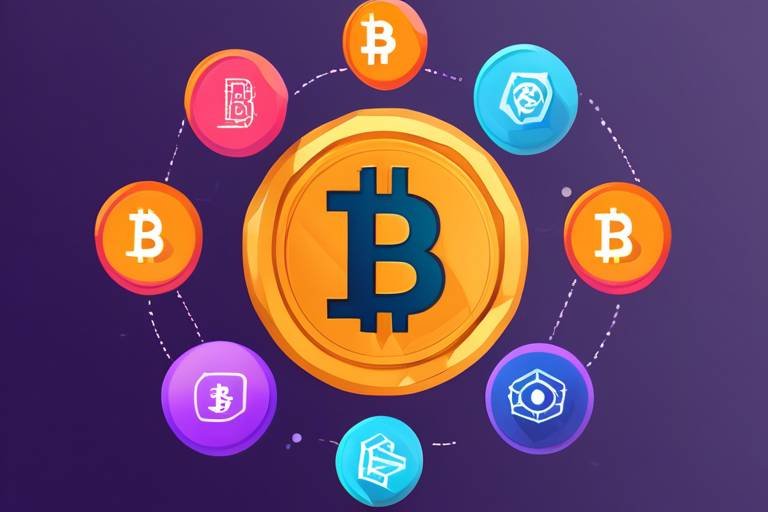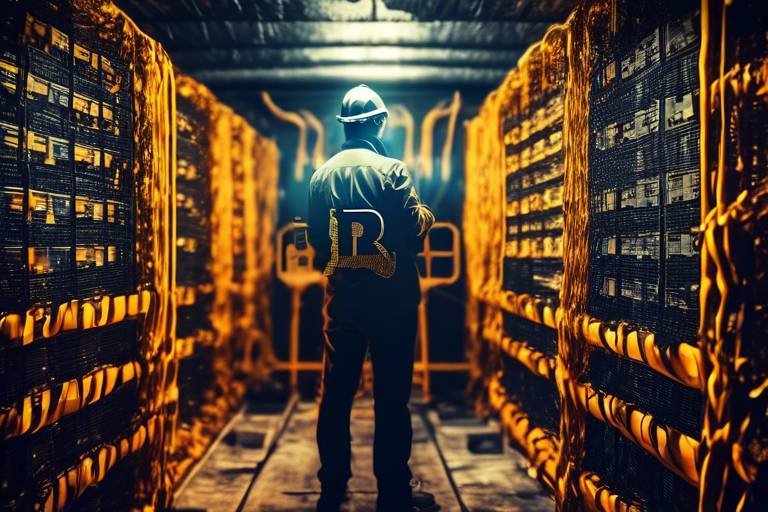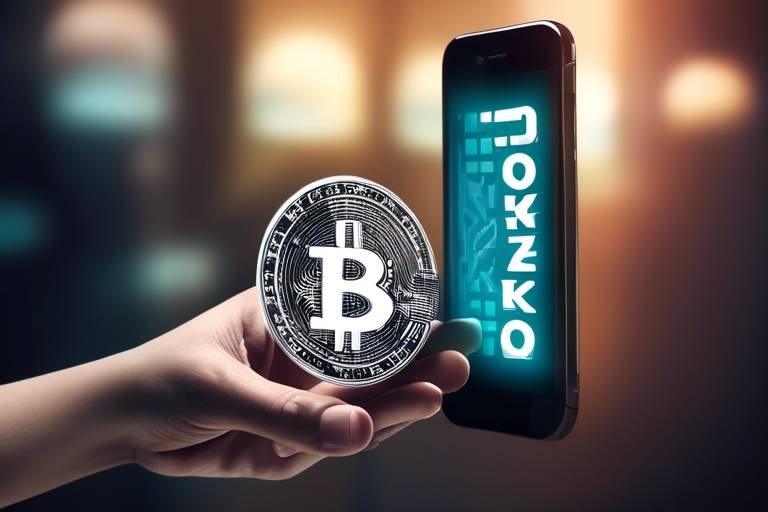The Role of Decentralized Finance in Global Economies
The world of finance is undergoing a seismic shift, and at the heart of this transformation is Decentralized Finance, commonly known as DeFi. Imagine a financial system where you don't have to rely on banks or other intermediaries to manage your money. Sounds revolutionary, right? DeFi is making that dream a reality by utilizing blockchain technology to create an open, permissionless, and transparent financial ecosystem. This article delves into how DeFi is reshaping global economies, offering unprecedented opportunities and challenges.
In traditional finance, accessing services often requires navigating through a maze of intermediaries, each taking their cut along the way. However, DeFi flips this model on its head. By eliminating these middlemen, it not only reduces costs but also increases efficiency and accessibility. This new paradigm is especially crucial in a world where millions remain unbanked and underserved by conventional financial institutions. DeFi is like a bridge connecting those who have been left behind in the financial system to a world of opportunities.
But what exactly does this mean for global economies? For starters, DeFi can enhance financial inclusion. With just a smartphone and internet access, individuals from even the most remote corners of the earth can participate in financial activities such as lending, borrowing, and trading. This democratization of finance empowers people, giving them control over their assets and enabling them to build wealth in ways that were previously unimaginable.
Moreover, DeFi platforms operate without geographical restrictions, which is a game-changer. Users can access financial services from anywhere in the world, breaking down the barriers that have historically limited access to capital. This global reach fosters innovation and competition, leading to better products and services for everyone. It's like opening the floodgates of opportunity, allowing ideas and talent to flow freely across borders.
However, the rise of DeFi is not without its challenges. As the technology evolves, so too do the regulatory landscapes that govern it. Policymakers are grappling with how to manage this new financial frontier while ensuring user protection and fostering innovation. It's a delicate balancing act that requires careful consideration and collaboration between governments and the DeFi community.
In summary, the role of decentralized finance in global economies is profound and multifaceted. It holds the potential to transform how we think about money, banking, and financial services. As we move forward, it will be crucial to navigate the challenges and seize the opportunities that DeFi presents. The future is bright, and the possibilities are endless.
- What is Decentralized Finance (DeFi)?
DeFi refers to financial services built on blockchain technology that eliminates intermediaries, allowing users to engage directly with financial products. - How does DeFi enhance financial inclusion?
DeFi provides access to financial services for unbanked individuals, enabling them to participate in the global economy with minimal barriers. - What are the main challenges facing DeFi?
Challenges include regulatory uncertainty, security vulnerabilities, and market volatility, which need to be addressed for DeFi to reach its full potential. - What is the future of Decentralized Finance?
The future of DeFi is expected to hold immense potential for innovation, growth, and a fundamental shift in global financial systems.

Understanding Decentralized Finance
Decentralized Finance, often abbreviated as DeFi, is a revolutionary approach to financial services that leverages blockchain technology to create an open and permissionless financial ecosystem. Unlike traditional finance, which relies heavily on intermediaries like banks and brokers, DeFi eliminates these middlemen, allowing users to interact directly with financial products and services. This shift not only enhances efficiency but also empowers individuals by giving them greater control over their assets.
At its core, DeFi operates on the principles of transparency, accessibility, and decentralization. By utilizing smart contracts—self-executing contracts with the terms of the agreement directly written into code—DeFi platforms can automate processes and ensure that all transactions are recorded on a public ledger. This level of transparency is a game changer, as it reduces the potential for fraud and manipulation, creating a more trustworthy environment for users.
To better understand how DeFi differs from traditional finance, consider the following key aspects:
- Accessibility: DeFi platforms are accessible to anyone with an internet connection, breaking down geographical barriers and enabling financial inclusion for the unbanked and underbanked populations.
- Lower Costs: By cutting out intermediaries, DeFi significantly reduces transaction fees, making financial services more affordable for everyone.
- Control: Users retain full control over their funds without relying on third-party institutions, which enhances personal sovereignty over financial decisions.
Moreover, DeFi encompasses a wide array of financial services, including lending, borrowing, trading, and insurance, all facilitated through decentralized applications (dApps). These dApps operate on various blockchain networks, with Ethereum being the most popular due to its robust smart contract capabilities. As the DeFi space continues to evolve, it is expected that more innovative solutions will emerge, further disrupting traditional financial systems.
In summary, the essence of DeFi lies in its ability to democratize finance, offering a transparent and inclusive alternative to the conventional banking system. This transformation not only opens up new opportunities for individuals but also poses a challenge to existing financial institutions to adapt to a rapidly changing landscape.

Benefits of Decentralized Finance
Decentralized Finance, commonly known as DeFi, is revolutionizing the financial landscape in ways we could only dream of a few years ago. Imagine a world where financial services are not confined to traditional banks, where anyone with an internet connection can access a plethora of financial tools. That's the essence of DeFi! It brings numerous advantages that not only benefit individual users but also have the potential to reshape entire economies.
One of the most compelling benefits of DeFi is its increased accessibility. Traditional financial systems often exclude vast populations due to strict requirements such as credit scores and geographical limitations. In stark contrast, DeFi platforms operate on the principle of inclusivity. They allow anyone, regardless of their financial background, to participate in the financial ecosystem. This is particularly significant for the unbanked and underbanked populations around the globe. For instance, a farmer in a remote village can access loans and insurance products without needing a bank account. This democratization of finance can help lift entire communities out of poverty.
Moreover, DeFi significantly lowers transaction costs. Traditional finance often comes with hefty fees for services like wire transfers, currency exchanges, and account maintenance. DeFi platforms, however, leverage blockchain technology to minimize these costs. By cutting out intermediaries, transactions can be executed at a fraction of the cost, making it more feasible for users to engage in financial activities. This is especially beneficial for microtransactions, which are often deemed unprofitable in traditional finance.
In addition to accessibility and cost, DeFi enhances security and transparency. Transactions on DeFi platforms are recorded on a public ledger, which means they are visible and verifiable by anyone. This level of transparency builds trust among users, as it becomes exceedingly difficult to manipulate or commit fraud. Furthermore, the use of smart contracts—self-executing contracts with the terms of the agreement directly written into code—adds another layer of security. Users can engage in transactions with confidence, knowing that the system is designed to protect their interests.
To illustrate the benefits of DeFi, consider the following table that compares traditional finance with DeFi:
| Aspect | Traditional Finance | Decentralized Finance |
|---|---|---|
| Accessibility | Limited to banked individuals | Open to anyone with internet access |
| Transaction Costs | High fees for services | Low or negligible fees |
| Security | Vulnerable to fraud and hacks | High transparency with blockchain security |
| Speed of Transactions | Can take days | Near-instant transactions |
As we can see, the advantages of DeFi are not just theoretical; they are practical solutions to real-world problems. By providing greater accessibility, lower costs, and enhanced security, DeFi is paving the way for a more equitable financial future. It empowers individuals and communities, allowing them to take control of their financial destinies. The implications of these benefits extend beyond personal finance, potentially leading to broader economic growth and stability.
In conclusion, the benefits of decentralized finance are profound and far-reaching. As we continue to explore this exciting frontier, it's essential to recognize how DeFi can not only enhance individual financial experiences but also contribute to a more inclusive global economy.
- What is DeFi? Decentralized Finance (DeFi) refers to financial services built on blockchain technology, which eliminates intermediaries.
- How does DeFi improve accessibility? DeFi platforms are open to anyone with internet access, allowing unbanked populations to access financial services.
- Are DeFi transactions safe? DeFi uses blockchain technology for transparency and security, but users should still be cautious of potential risks.
- What are smart contracts? Smart contracts are self-executing contracts with the terms directly written into code, enhancing security and efficiency in transactions.

Accessibility and Inclusivity
One of the most significant advantages of Decentralized Finance (DeFi) is its potential to provide financial services to the unbanked and underbanked populations around the globe. Imagine a world where anyone, regardless of their geographical location or economic status, can access financial services. This is not just a dream; it is becoming a reality thanks to DeFi. Traditional financial systems often impose stringent requirements that exclude millions from participating in the economy. In contrast, DeFi platforms operate on the principles of openness and inclusivity, allowing individuals to engage in financial activities without the need for a bank account or credit history.
The accessibility of DeFi is a game changer. By leveraging blockchain technology, DeFi removes the need for intermediaries, which typically act as gatekeepers in traditional finance. Users can interact directly with financial services through smart contracts, which are self-executing contracts with the terms of the agreement directly written into code. This direct interaction reduces costs and increases efficiency, making financial services more accessible than ever before.
Furthermore, DeFi platforms are designed to be user-friendly, often featuring intuitive interfaces that make it easy for anyone to navigate their services. This is crucial for fostering inclusivity. For instance, many DeFi platforms offer educational resources and community support, empowering users with the knowledge they need to participate confidently.
To illustrate this point, consider the following benefits of DeFi in promoting accessibility:
- Global Reach: DeFi platforms operate without geographical restrictions, allowing users from different parts of the world to access financial services. This is especially important for individuals in developing countries where traditional banking infrastructure may be lacking.
- Lower Barriers to Entry: With minimal requirements for participation, such as just an internet connection and a digital wallet, DeFi reduces barriers for users. This accessibility can democratize finance, enabling innovation and creativity among a broader audience.
- Empowerment: By providing tools and resources, DeFi empowers marginalized communities, allowing them to take control of their financial futures. This empowerment can lead to economic growth and stability in regions that have been historically underserved.
In conclusion, the accessibility and inclusivity offered by DeFi are not just advantages; they represent a fundamental shift in how we perceive and engage with financial systems. By breaking down barriers and providing opportunities for everyone, DeFi is paving the way for a more equitable financial landscape. As we continue to explore the potential of decentralized finance, it’s essential to recognize its role in fostering a more inclusive economy for all.

Global Reach
One of the most groundbreaking aspects of Decentralized Finance, or DeFi, is its . Unlike traditional financial systems that often operate within geographical boundaries, DeFi platforms are designed to be accessible to anyone with an internet connection. Imagine being able to send money to a friend across the globe in seconds, without the need for a bank or intermediary. This is the power of DeFi, and it’s reshaping how we think about financial transactions.
DeFi platforms utilize blockchain technology, which means they can offer services that transcend borders. This is particularly significant for individuals in developing countries who may not have access to traditional banking infrastructure. With DeFi, the potential for financial inclusion is immense, as it allows users to participate in the global economy without the constraints typically imposed by local financial institutions.
Moreover, the of DeFi enables the creation of a more interconnected financial ecosystem. Users from various parts of the world can engage in lending, borrowing, and trading without worrying about currency conversion or high fees. This is not just a convenience; it can lead to lower costs and more efficient markets. For instance, a farmer in Africa can access loans from investors in Europe, all facilitated through a decentralized platform, thus bridging the gap between supply and demand across continents.
However, this global accessibility does come with its own set of challenges. Different countries have varying regulations regarding financial transactions, and navigating these can be complex. Additionally, while DeFi aims to democratize finance, it also raises questions about user protection and the potential for scams, particularly in regions where users may not be as familiar with the technology.
In summary, the of DeFi is a double-edged sword. It holds the promise of financial inclusivity and innovation, but it also requires careful consideration of regulatory and security issues. As more people around the world gain access to these platforms, the landscape of finance will continue to evolve in ways we are only beginning to understand.
- What is Decentralized Finance (DeFi)? DeFi refers to financial services that are built on blockchain technology, allowing users to conduct transactions without intermediaries.
- How does DeFi promote financial inclusion? DeFi platforms provide access to financial services for the unbanked and underbanked populations, enabling them to participate in the global economy.
- What are the risks associated with DeFi? Risks include regulatory uncertainty, security vulnerabilities, and market volatility, which can affect users' assets and investments.
- Can anyone use DeFi platforms? Yes, anyone with an internet connection can access DeFi platforms, making them available to a global audience.

Lower Barriers to Entry
In the realm of finance, traditional systems often impose a multitude of barriers that can make it challenging for individuals to access essential services. These barriers can include high fees, extensive documentation requirements, and the need for a minimum balance. However, Decentralized Finance (DeFi) is revolutionizing this landscape by significantly lowering these barriers, making financial services more accessible to everyone, regardless of their socioeconomic status.
One of the most remarkable aspects of DeFi is its ability to democratize finance. With just an internet connection and a digital wallet, anyone can participate in the financial ecosystem. This is a game-changer for individuals in underserved regions where traditional banking infrastructure is lacking. Imagine someone in a remote village with no bank branch nearby; with DeFi, they can access loans, savings, and investment opportunities right from their smartphone. This level of accessibility is akin to opening the floodgates of financial services to populations that have long been marginalized.
Moreover, DeFi platforms typically require minimal documentation to get started. Unlike traditional banks that may demand proof of income, credit scores, and extensive identification, many DeFi services allow users to engage with just a wallet address. This streamlined process not only expedites access but also encourages innovation as individuals can experiment with different financial products without the fear of hefty fees or penalties. The ease of entry fosters a vibrant ecosystem where new ideas can flourish, much like a garden that thrives when given ample sunlight and water.
To illustrate the contrast between traditional finance and DeFi, consider the following table:
| Aspect | Traditional Finance | Decentralized Finance (DeFi) |
|---|---|---|
| Documentation Requirements | Extensive, including proof of income and ID | Minimal, often just a wallet address |
| Fees | High fees for transactions and account maintenance | Lower fees, often negligible |
| Geographical Restrictions | Limited to specific regions or countries | Global access for anyone with internet |
| Account Minimums | Often requires a minimum balance | No minimum balance required |
This table clearly outlines how DeFi dismantles traditional barriers, paving the way for a more inclusive financial future. As we explore the implications of these lower barriers, it becomes evident that DeFi not only empowers individuals but also stimulates economic growth by encouraging participation from previously excluded demographics.
In conclusion, the lowered barriers to entry provided by DeFi stand as a testament to the transformative power of technology in finance. By enabling broader access to financial services, DeFi fosters innovation, encourages economic participation, and ultimately contributes to a more equitable financial landscape. It's like handing out keys to a previously locked vault, allowing everyone to partake in the wealth of opportunities that finance can offer.
- What is Decentralized Finance (DeFi)? DeFi refers to financial services built on blockchain technology, which eliminates the need for intermediaries like banks.
- How does DeFi lower barriers to entry? DeFi platforms typically require minimal documentation and fees, allowing anyone with an internet connection to access financial services.
- Can anyone use DeFi services? Yes, as long as you have an internet connection and a digital wallet, you can access DeFi services from anywhere in the world.
- What are the risks associated with DeFi? While DeFi offers many benefits, it also comes with risks such as market volatility and security vulnerabilities.

Security and Transparency
In the realm of finance, security and transparency are not just buzzwords; they are the bedrock upon which trust is built. Decentralized Finance (DeFi) leverages the power of blockchain technology to create a financial ecosystem that is inherently more secure than traditional systems. But how does this work, and what does it mean for users? Let’s dive into the details.
At its core, DeFi operates on a decentralized network of computers, or nodes, that validate transactions through complex algorithms. This eliminates the need for a central authority, which is often a single point of failure in traditional financial systems. By distributing control across a network, DeFi significantly reduces the risk of fraud and hacking. In fact, the transparency of blockchain allows anyone to verify transactions in real-time, creating an environment where users can trust the system without needing to trust a central entity.
Moreover, the transparency offered by DeFi is revolutionary. Every transaction is recorded on a public ledger, which means that anyone can view the history of transactions. This level of openness not only fosters trust but also holds participants accountable. Imagine walking into a bank where every transaction is visible to the public; it’s a radical shift from the secrecy that often shrouds traditional banking. Here are some key aspects of security and transparency in DeFi:
- Immutable Records: Once a transaction is confirmed on the blockchain, it cannot be altered or deleted. This immutability ensures that all records are permanent and trustworthy.
- Smart Contracts: DeFi platforms utilize smart contracts—self-executing contracts with the terms of the agreement directly written into code. These contracts automatically enforce agreements without the need for intermediaries, reducing the chance of human error.
- Auditable Systems: The open-source nature of many DeFi projects means that their code can be audited by anyone. This transparency helps identify vulnerabilities before they can be exploited.
However, while DeFi's security features are robust, they are not without risks. Users must remain vigilant about the platforms they engage with, as not all DeFi projects are created equal. Some may lack the necessary security measures, exposing users to potential losses. It’s crucial to conduct thorough research and choose platforms that have a proven track record of security.
In conclusion, the integration of security and transparency in DeFi represents a paradigm shift in how we approach financial services. By harnessing blockchain technology, DeFi not only enhances the safety of transactions but also democratizes access to financial information. As we move forward, these principles will be vital in shaping the future of finance, ensuring that users can engage with confidence and clarity.

Challenges Facing Decentralized Finance
Decentralized Finance (DeFi) has emerged as a revolutionary force in the financial landscape, yet it is not without its challenges. As we navigate through this innovative terrain, several hurdles need to be addressed to ensure the sustainability and growth of DeFi platforms. These challenges range from regulatory uncertainties to security vulnerabilities and market volatility, each posing significant implications for users and the broader financial ecosystem.
One of the most pressing concerns is regulatory uncertainty. As governments and regulatory bodies around the world grapple with how to approach DeFi, the lack of clear guidelines creates an environment of unpredictability. For instance, while some jurisdictions embrace DeFi innovations, others may impose stringent regulations that could stifle growth. This inconsistency can lead to confusion among users and developers alike, potentially discouraging investment and innovation in the space. It's essential for regulators to strike a balance between protecting consumers and fostering an environment that encourages technological advancement.
In addition to regulatory challenges, security vulnerabilities present a significant risk to DeFi platforms. Although blockchain technology is inherently secure, it is not immune to attacks. Common vulnerabilities include smart contract bugs, which can be exploited by malicious actors, leading to substantial financial losses. For example, the infamous DAO hack in 2016 highlighted how a flaw in a smart contract could result in the theft of millions of dollars. As the DeFi space continues to grow, developers must prioritize robust security measures to protect users' assets. This includes conducting thorough audits of smart contracts and implementing multi-signature wallets to enhance security.
Furthermore, market volatility is another challenge that cannot be overlooked. The cryptocurrency market is known for its wild price swings, and DeFi is no exception. This volatility can lead to drastic changes in asset values, affecting users' investments and the overall stability of DeFi platforms. For example, a sudden drop in the value of a collateralized asset could trigger liquidation events, causing users to lose their funds. To mitigate these risks, DeFi platforms need to develop mechanisms that can stabilize prices and protect users from extreme market fluctuations.
Despite these challenges, the DeFi landscape is continually evolving. As the technology matures and best practices are established, it is likely that many of these issues will be addressed. Collaboration between developers, users, and regulators will be crucial in creating a safe and sustainable environment for decentralized finance to thrive.
- What is DeFi? DeFi, or Decentralized Finance, refers to financial services built on blockchain technology that operate without intermediaries, allowing for peer-to-peer transactions.
- What are the main challenges facing DeFi? The main challenges include regulatory uncertainty, security vulnerabilities, and market volatility, which can impact user trust and platform stability.
- How can security risks in DeFi be mitigated? Security risks can be mitigated through thorough smart contract audits, implementing multi-signature wallets, and continuously monitoring for vulnerabilities.
- Is DeFi safe to use? While DeFi offers many benefits, users should be aware of the risks involved and take necessary precautions to protect their assets.

Regulatory Concerns
As the world of Decentralized Finance (DeFi) continues to expand at an astonishing pace, it brings with it a host of that cannot be overlooked. Unlike traditional financial systems, which operate under a well-defined regulatory framework, DeFi exists in a somewhat grey area. This lack of clear regulation poses significant challenges, both for the platforms themselves and for the users who rely on them.
One of the primary issues is the uncertainty surrounding regulations. Governments around the globe are still trying to catch up with the rapid advancements in blockchain technology and the innovative financial products that DeFi offers. As they scramble to formulate regulations, the fear of over-regulation looms large. If regulations become too stringent, they might stifle innovation and drive developers away from creating new solutions. On the other hand, a lack of regulation can lead to fraud and malpractice, leaving users vulnerable.
Another critical aspect is the geographical disparity in regulatory approaches. Different countries have different stances on cryptocurrencies and DeFi platforms. For instance, while some nations embrace DeFi and encourage its growth, others impose heavy restrictions or outright bans. This inconsistency creates a challenging environment for DeFi projects that aspire to operate on a global scale. It raises the question: how can a platform ensure compliance across multiple jurisdictions while maintaining its decentralized nature?
To illustrate the complexity of this situation, consider the following table that outlines the regulatory stance of various countries towards DeFi:
| Country | Regulatory Stance |
|---|---|
| United States | Mixed; some states embrace DeFi, while others impose strict regulations. |
| European Union | Working on comprehensive regulations, aiming for a balanced approach. |
| China | Strictly prohibits cryptocurrencies and DeFi activities. |
| Singapore | Encouraging innovation with a clear regulatory framework. |
Furthermore, user protection is a significant concern in the regulatory landscape. As DeFi platforms often operate without intermediaries, users may find themselves without recourse in the event of a dispute or loss of funds. This lack of consumer protection raises alarms for potential investors, who may hesitate to engage with DeFi due to fears of losing their assets without any legal backing. Regulatory bodies must find a way to balance the need for innovation with the necessity of protecting users.
In conclusion, while the regulatory landscape for DeFi is still evolving, it is crucial for stakeholders to engage in discussions about creating a framework that fosters innovation while ensuring user protection. As we move forward, the challenge will be to strike the right balance between regulation and the decentralized ethos that makes DeFi so appealing. Will regulators embrace DeFi as a revolutionary force in finance, or will they impose restrictions that hamper its growth? Only time will tell.
- What is DeFi? - Decentralized Finance (DeFi) refers to financial services built on blockchain technology that operate without intermediaries.
- Why are regulations important for DeFi? - Regulations help protect users from fraud, ensure compliance, and foster a stable financial ecosystem.
- How does DeFi differ from traditional finance? - DeFi eliminates intermediaries, allowing for peer-to-peer transactions and greater accessibility.
- What challenges does DeFi face? - Key challenges include regulatory uncertainty, security risks, and market volatility.

Security Risks
While Decentralized Finance (DeFi) platforms promise a revolution in the financial sector, they are not without their fair share of . The very nature of DeFi, which operates on open-source protocols and blockchain technology, can expose users to vulnerabilities that traditional financial systems often mitigate with established regulations and security measures. One of the most pressing concerns is the risk of smart contract vulnerabilities. These contracts are self-executing agreements with the terms directly written into code. If there are flaws in the code, hackers can exploit these weaknesses, leading to significant financial losses for users.
Moreover, the lack of a central authority in DeFi means that there is no one to turn to in case of an incident. Unlike traditional banks, which have customer service and insurance mechanisms in place, DeFi users often have to rely on the community or developers for assistance, which can be a daunting prospect. This absence of a safety net can result in a sense of vulnerability that deters potential users from fully embracing DeFi.
Another significant risk is the potential for phishing attacks. Cybercriminals often target DeFi users through deceptive tactics that lure them into revealing their private keys or other sensitive information. For instance, they may create fake websites that mimic legitimate DeFi platforms, tricking users into entering their credentials. Once the attackers gain access, they can drain the user's wallet in seconds, leaving them with little recourse to recover lost funds.
To illustrate the various security risks associated with DeFi, consider the following table:
| Type of Risk | Description |
|---|---|
| Smart Contract Vulnerabilities | Exploits in the code can lead to financial losses. |
| Phishing Attacks | Deceptive tactics to steal sensitive information. |
| Market Manipulation | Price volatility can be exacerbated by malicious actors. |
| Liquidity Risks | Insufficient liquidity can lead to slippage and losses. |
Additionally, market manipulation poses a significant risk to DeFi users. Since many DeFi platforms operate with relatively low liquidity compared to traditional markets, malicious actors can manipulate prices, creating artificial volatility that can lead to substantial losses for unsuspecting investors. This can create an environment of uncertainty, making it difficult for users to trust the stability of DeFi platforms.
In conclusion, while DeFi represents a groundbreaking shift in how we view financial systems, users must remain vigilant about the inherent security risks. By understanding these vulnerabilities and taking proactive measures, such as using hardware wallets, enabling two-factor authentication, and staying informed about the latest security practices, users can better protect their assets in this exciting yet perilous landscape.

The Future of Decentralized Finance
The future of Decentralized Finance (DeFi) is not just bright; it’s downright dazzling! As we stand on the precipice of a financial revolution, the possibilities seem endless. Imagine a world where financial services are as accessible as a smartphone app and where individuals can control their own assets without the need for traditional banks. This vision is rapidly becoming a reality, thanks to the innovative spirit driving DeFi. But what exactly does the future hold for this transformative sector? Let’s dive into some exciting trends and potential developments that could reshape the financial landscape.
One of the most promising aspects of DeFi is its ability to innovate rapidly. Unlike traditional financial systems that often move at a snail's pace due to regulatory hurdles and legacy infrastructure, DeFi is nimble and flexible. New protocols and platforms are emerging almost daily, each offering unique solutions to age-old financial problems. For instance, we might see the rise of decentralized insurance platforms that allow users to pool their resources and insure against risks without relying on a centralized authority.
Furthermore, the integration of artificial intelligence (AI) and machine learning into DeFi platforms could revolutionize how we approach lending and risk assessment. Imagine algorithms that analyze vast amounts of data to determine creditworthiness, allowing more individuals to access loans without the traditional barriers. This shift could lead to a more inclusive financial ecosystem where everyone has a fair shot at financial stability.
However, with great potential comes great responsibility. The DeFi space must address several challenges to ensure its sustainable growth. For instance, the ongoing discussions surrounding regulation are critical. As governments around the world begin to recognize the implications of DeFi, they are also grappling with how to create a regulatory framework that protects consumers without stifling innovation. The balance between innovation and regulation will be a key theme in the coming years.
Security will also remain a top priority. While DeFi platforms are built on the premise of transparency and security, they are not immune to hacks and vulnerabilities. As the industry matures, we can expect to see more robust security measures and insurance products designed to protect users' assets. This could include decentralized insurance protocols that provide coverage against smart contract failures or hacks, offering users peace of mind as they engage with these platforms.
Moreover, as DeFi continues to grow, we will likely see increased collaboration between traditional financial institutions and DeFi platforms. Banks may start to adopt blockchain technology and integrate DeFi services into their offerings, creating a hybrid model that combines the best of both worlds. This partnership could lead to a more efficient and user-friendly financial ecosystem, where the benefits of DeFi are accessible to a broader audience.
In conclusion, the future of decentralized finance is filled with potential and possibilities. As we navigate this exciting frontier, it’s crucial for all participants—developers, users, and regulators—to work together to build a safe and inclusive financial system. The road ahead may be challenging, but the rewards are undoubtedly worth the journey. Are you ready to embrace the future of finance?
- What is Decentralized Finance (DeFi)? DeFi refers to financial services that operate on blockchain technology, allowing users to transact without intermediaries like banks.
- How does DeFi improve accessibility? DeFi platforms can provide financial services to unbanked populations, allowing anyone with internet access to participate in the financial ecosystem.
- What are the security risks associated with DeFi? While DeFi enhances security through blockchain, it is still vulnerable to hacks and smart contract failures, necessitating robust security measures.
- Will DeFi replace traditional finance? While DeFi offers innovative solutions, it is more likely to coexist with traditional finance, creating a hybrid model that benefits users.
Frequently Asked Questions
- What is Decentralized Finance (DeFi)?
Decentralized Finance, or DeFi, refers to a financial ecosystem built on blockchain technology that operates without traditional intermediaries like banks. It allows users to engage in financial transactions directly with one another, promoting transparency and efficiency.
- How does DeFi improve accessibility to financial services?
DeFi platforms provide financial services to anyone with internet access, effectively reaching unbanked and underbanked populations. By lowering entry barriers and eliminating geographical restrictions, DeFi empowers marginalized communities to participate in the financial system.
- What are the main benefits of using DeFi?
Some key benefits of DeFi include lower transaction costs, enhanced security through blockchain technology, and greater financial inclusivity. Users can enjoy faster transactions without the high fees typically associated with traditional financial services.
- Are there any risks associated with DeFi?
Yes, while DeFi offers numerous advantages, it also presents challenges such as regulatory uncertainty, security vulnerabilities, and market volatility. Users must be aware of these risks and take necessary precautions to protect their assets.
- How does DeFi ensure security and transparency?
DeFi leverages blockchain technology to provide a secure and transparent environment for transactions. Every transaction is recorded on a public ledger, making it difficult for fraud to occur and building trust among users.
- What is the future of Decentralized Finance?
The future of DeFi is bright, with ongoing innovations and emerging trends expected to reshape global economies. As the sector matures, we can anticipate improved regulatory frameworks, enhanced security measures, and wider adoption of DeFi solutions.



















